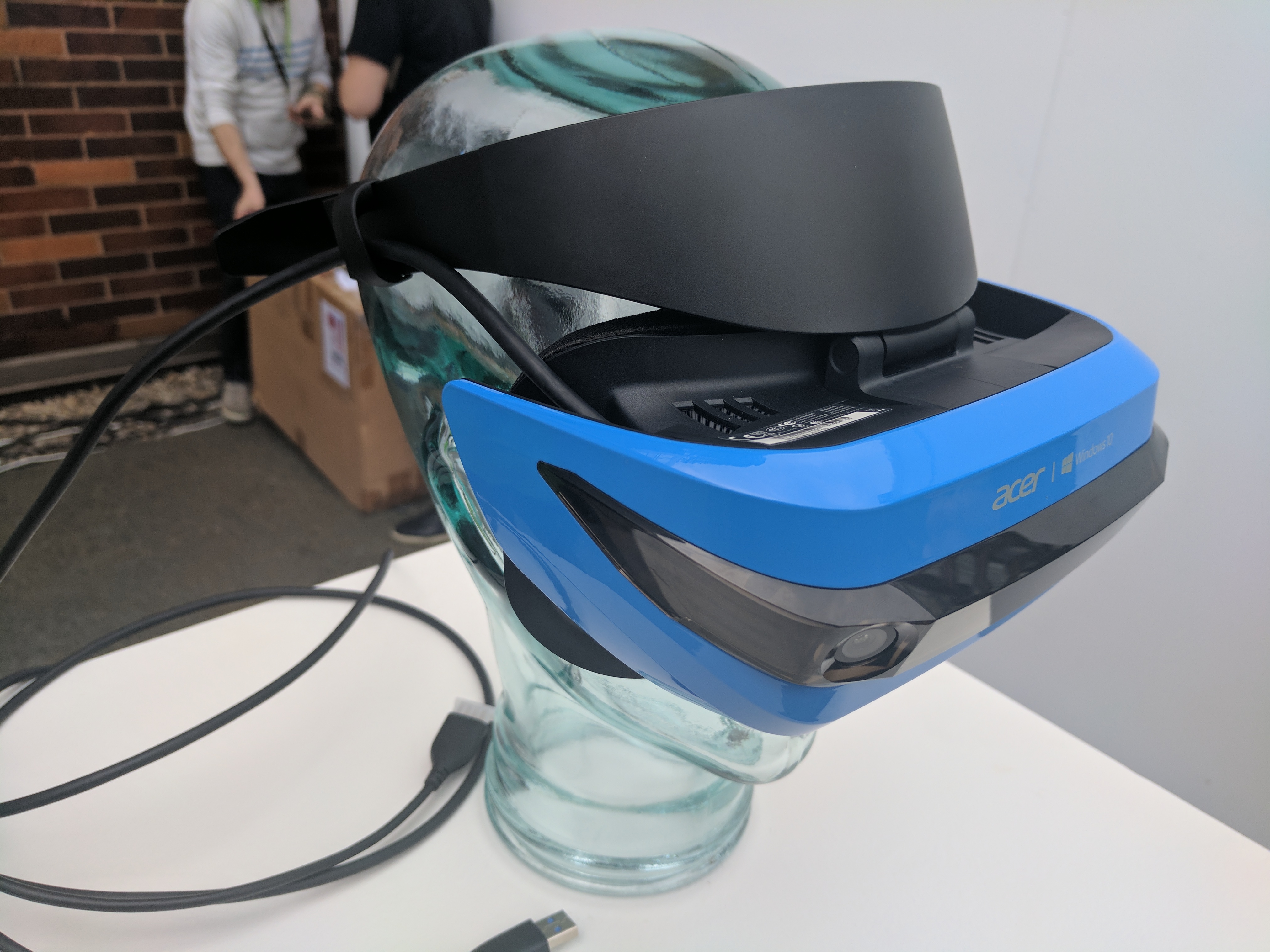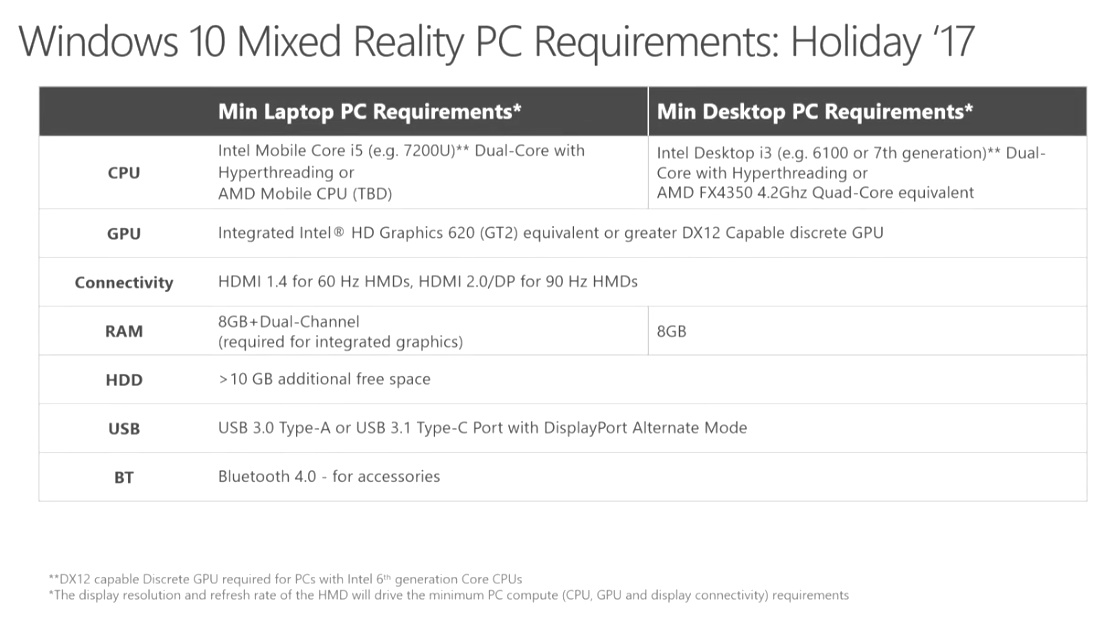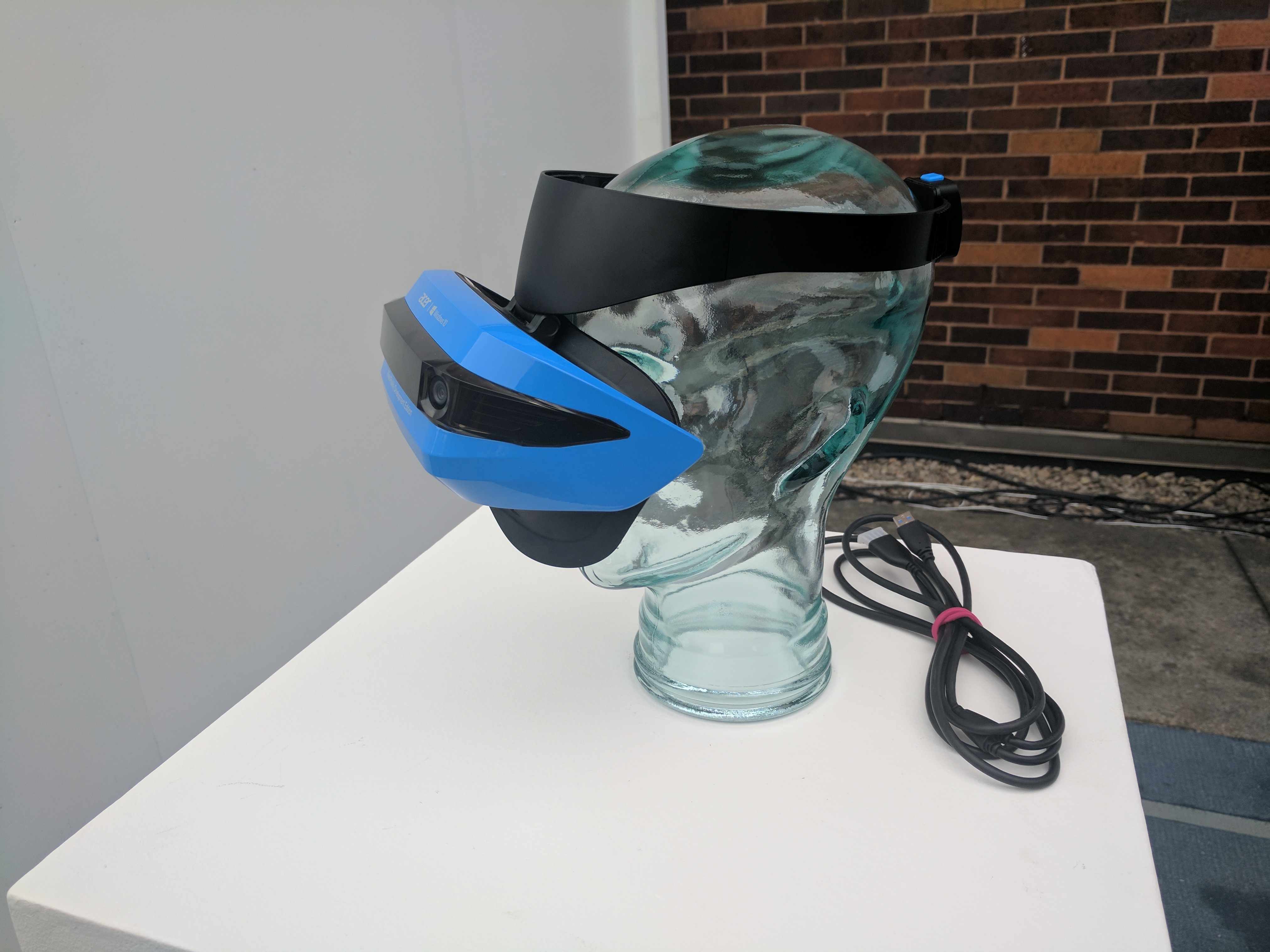Acer's Mixed Reality HMD, Hands On
Acer’s new Mixed Reality Developer HMD may be somewhat misleading with its nomenclature, but the new virtual reality headset certainly turned heads at the company’s annual Next@Acer event. We were able to get some sparse details of the HMD at GDC, but Acer filled us in on the full specifications and let us see its capabilities for ourselves.
Specifications
The Acer Mixed Reality Developer HMD features a 2880 x 1440 (1440 x 1440 per eye) display with up to a 90Hz refresh rate. The term “up to” was used to describe the refresh rate, and we can take this to mean that it will also operate at 60Hz depending on the HDMI output of the host PC (HDMI 1.4 laptops, for example). The display is also hinged and can be lifted away from your face in case you want to sip a drink or take a look at the real world without removing the headset.
The inside-out tracking is provided by the two sensors in the front of the HMD, which detect the space around you in order to achieve room-scale 6DoF. However, they don’t have a passthrough to import the environment into a mixed reality experience.
The headset supports audio output and microphone input via a 3.5mm combo jack and also sports an accelerometer, gyroscope, magnetometer, and a proximity sensor. The HMD connects to a PC via a single HDMI 2.0/USB 3.0 cable, and it's compatible with an Xbox controller.
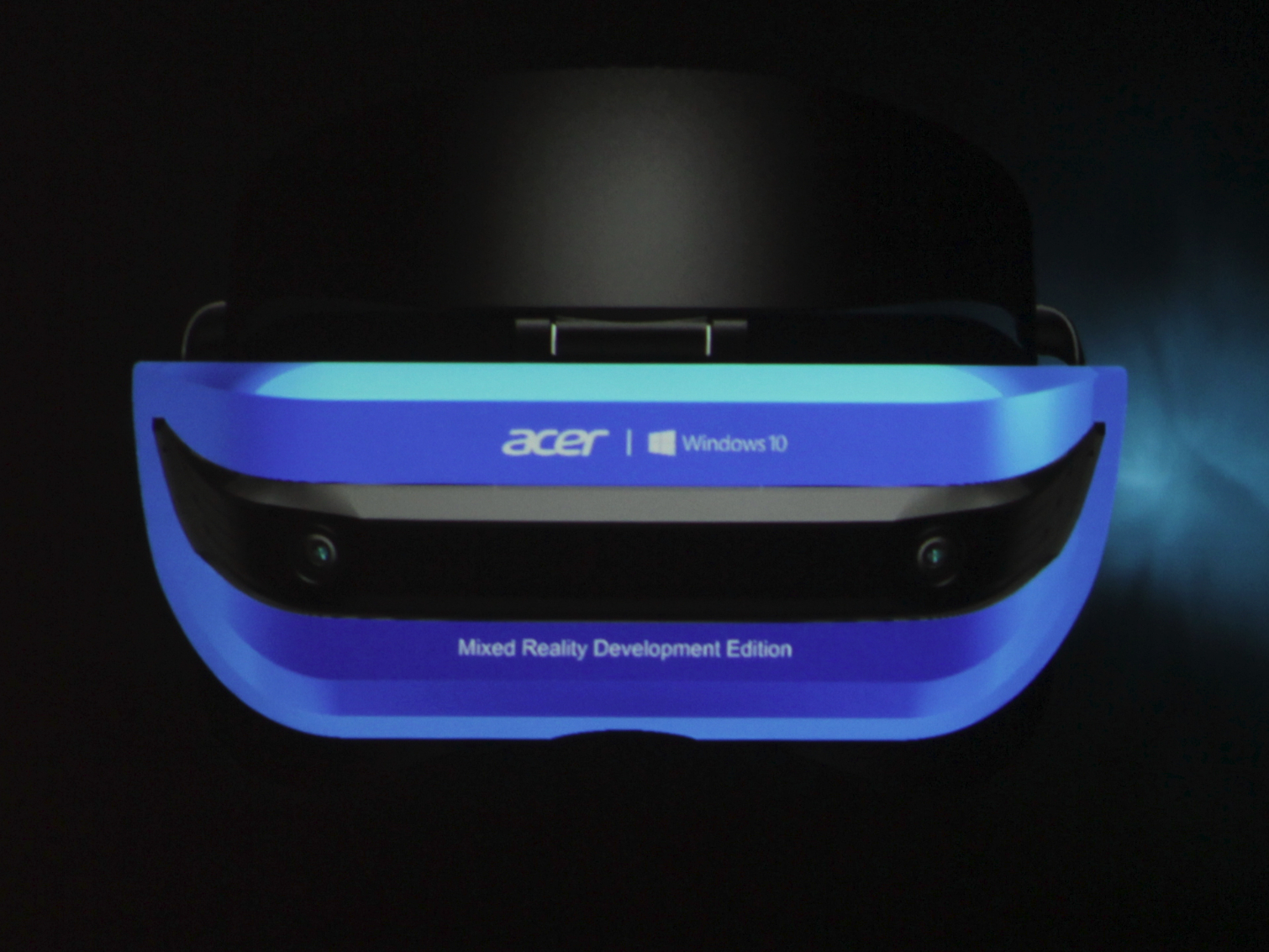

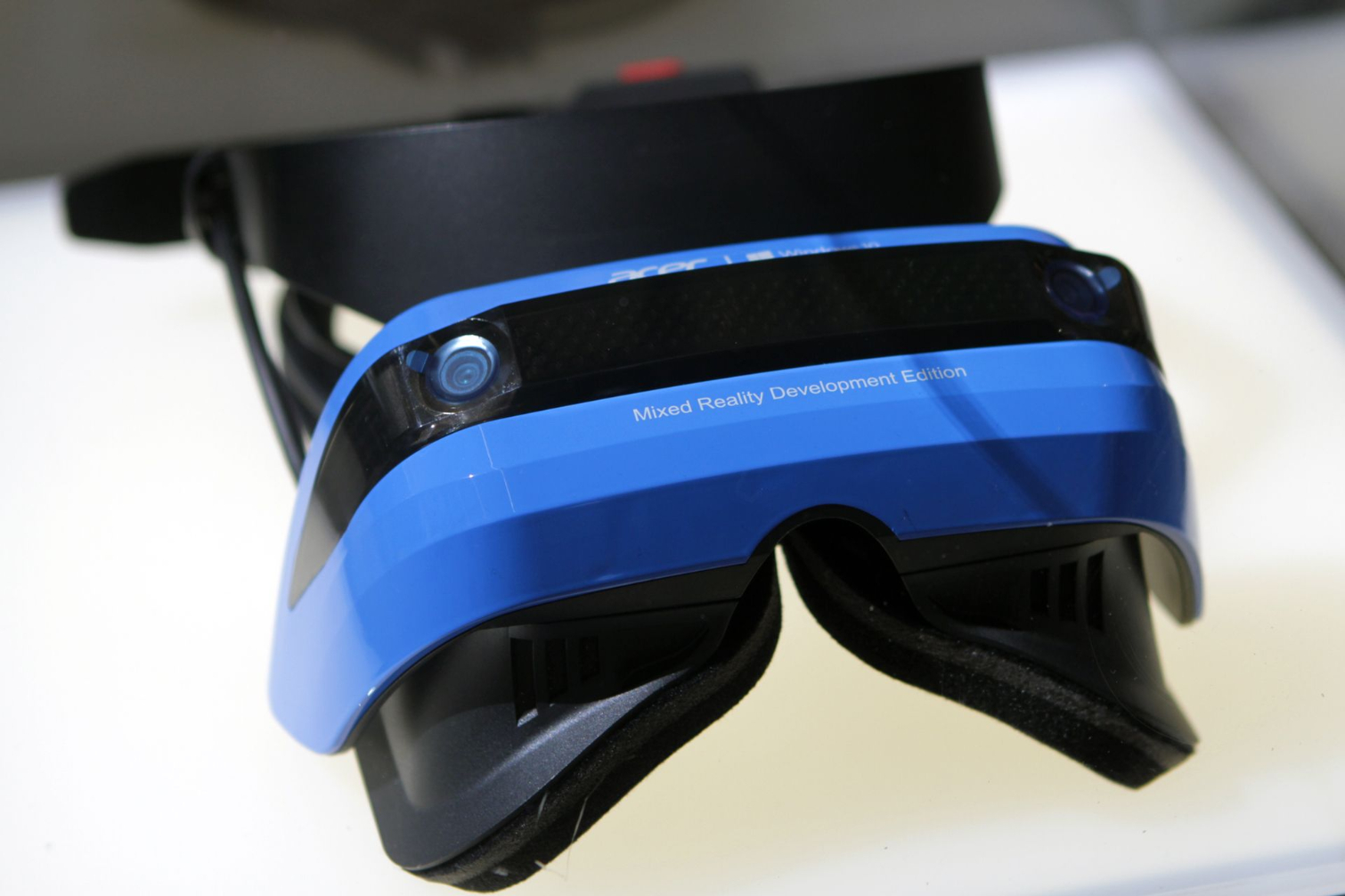
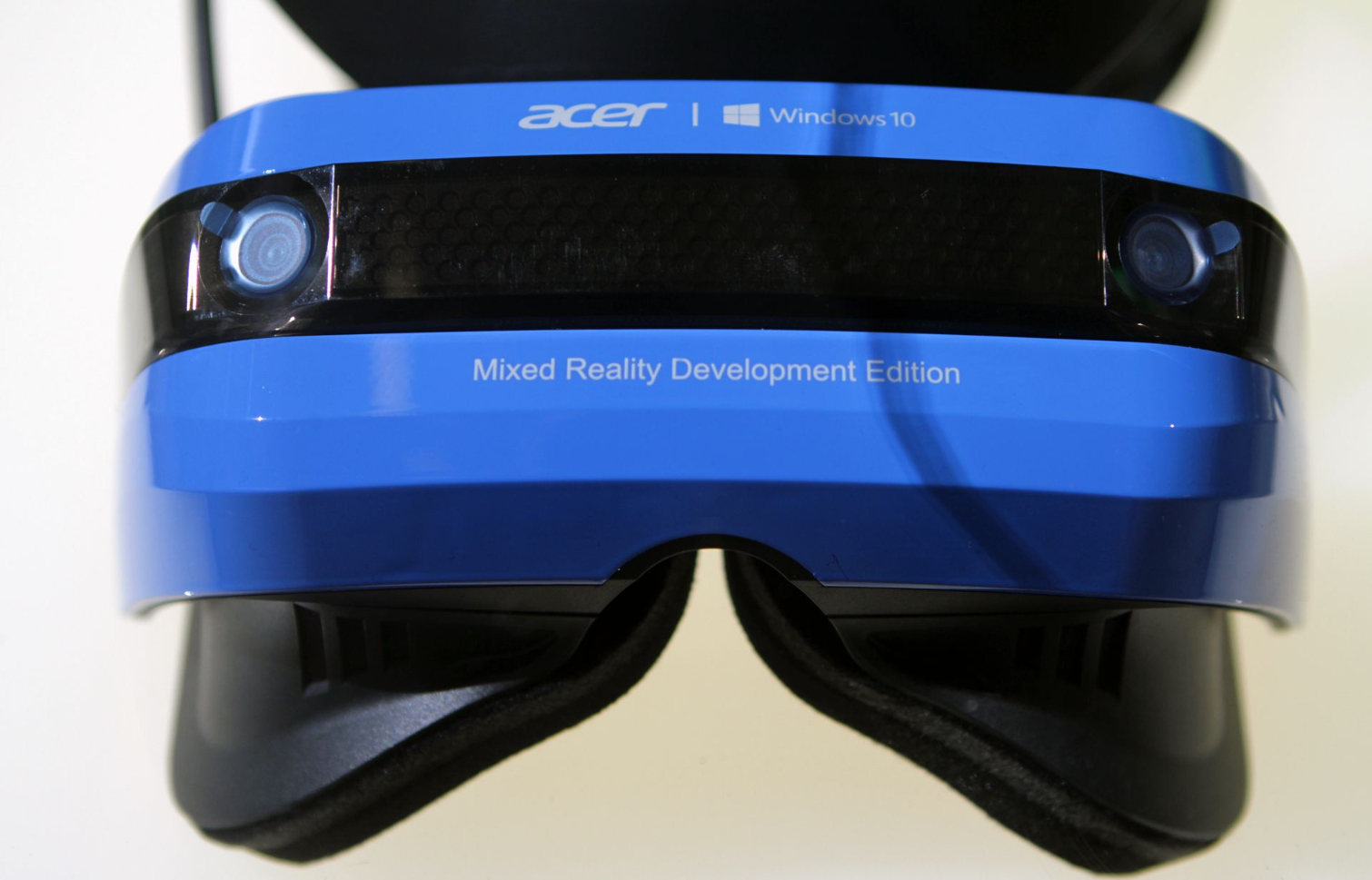


Minimum Requirements
Acer representatives told us that the Acer Mixed Reality Developer HMD requires a PC with the minimum requirements, which were previously disclosed (and pictured below). The PC also needs the Windows 10 Creators update.
Despite the low performance entry point, Acer gave us a demonstration of the HMD connected to one of its powerful Predator-branded gaming laptops, which far exceed the minimum specs.
Calibrating The Height
Because of my above-average height (6’7”) I had to calibrate the height of the headset before I used it. The Acer rep input my height into the PC. Then I had to hold the HMD at eye level for a ten-second countdown. After it completed, the program asked if we wanted to retrace the room scale environment, but we skipped that part. However, we were told that the HMD is used to trace the play space with a similar software-guided procedure.
Get Tom's Hardware's best news and in-depth reviews, straight to your inbox.
Comfortable Fit, No IPD Adjustment
The headset is easy to put on, with a forehead support and adjustable push-button strap that makes the Acer Mixed Reality Development HMD fit comfortably on your head, with the weight distributed evenly (it’s not clumsy). However, the lack of IPD (interpupillary distance) adjustment makes properly lining up the lenses somewhat difficult; you just have to adjust the headset until it appears clearest.
The strap itself was somewhat flimsy and hard to set in place, but Acer assured us the final version would be getting an adjustment knob to make it easier. Once I had the HMD properly fit, we launched into our first Windows 10 Mixed Reality demo.
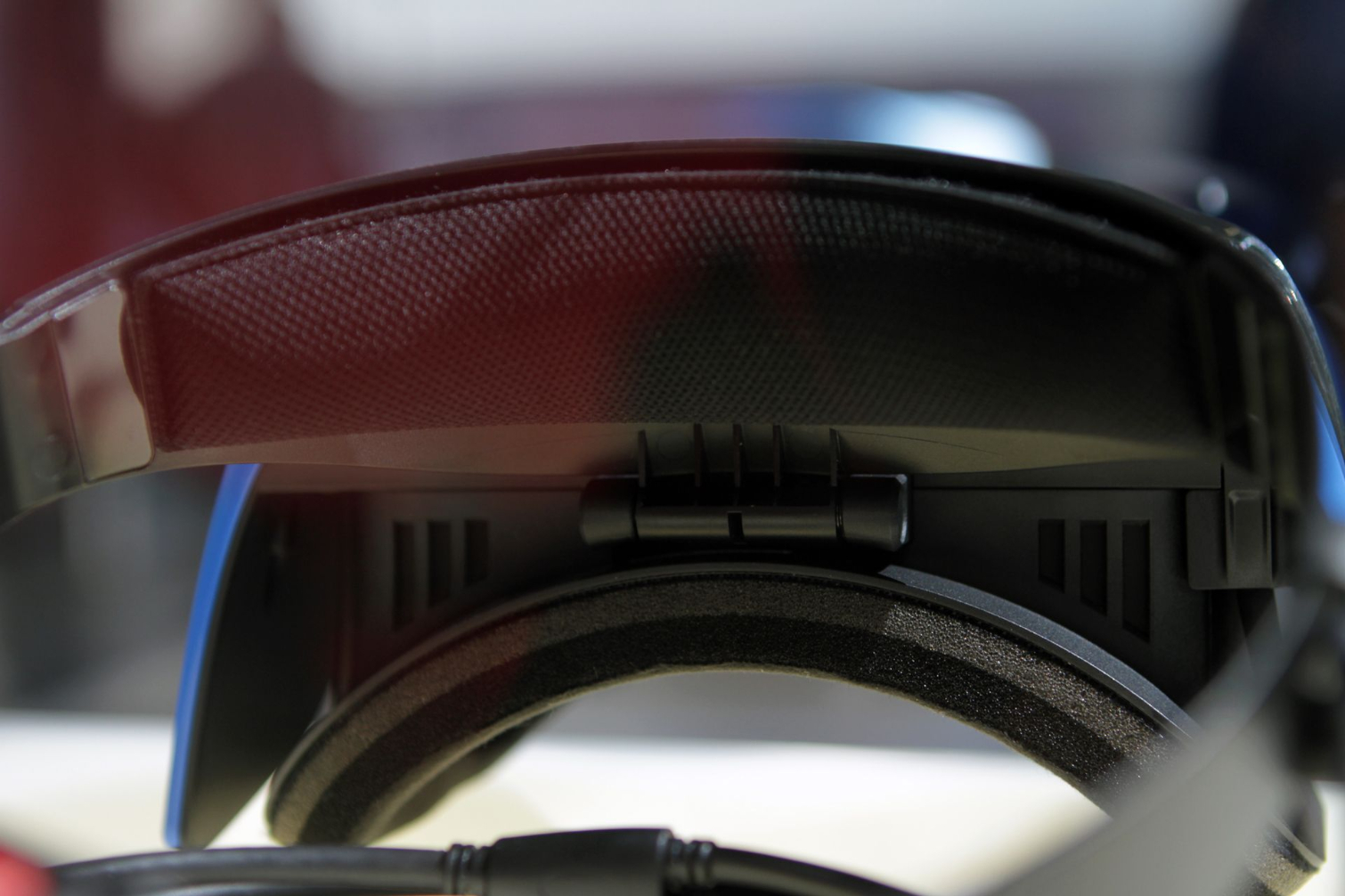

Swanky Apartment, Windows Universal Apps
We weren’t allowed to take pictures or screen caps of the virtual environment, so you’ll have to use your imagination a bit as I describe my experience. The virtual operating system takes the form of a swanky modern condo, complete with an office and a balcony with a view. We were instructed to teleport to the balcony using the Xbox controller and then "enter" a program (which hung in space along the wall). It loaded a 360-degree video that had been filmed on top of a helmet worn by skier. Suddenly I was racing down the slope of a mountain with another skier, which was somewhat nauseating. However, the video was highly detailed, and swinging my arms made the nausea subside (a matched physical interaction with what your eyes see generally helps this).
Once the video completed, we exited the program and headed to the office (again, teleporting with the Xbox controller), where three windows were suspended in the air around the virtual desk, giving us access to Windows Universal Apps including the weather widget (high precipitation in NYC that day), Edge browser, and Outlook.
I was instructed to return to the previous room and load a program that could take me to different locations. After a long loading time (I lifted the display away from my face to chat with the Acer rep for a good minute), I found myself on a hot air balloon above a beautiful European city. The scene was highly detailed (explaining the long loading time), and I was able to walk to the edge of the balloon and look down at the awe-inspiring city.
Other Thoughts
I found Acer’s Mixed Reality HMD to be strikingly similar to the Oculus Rift at its retail launch in both functionality and performance. It doesn’t currently have tracked controllers and relies on an Xbox controller to let you navigate the OS and programs. This limits the immersion of the experience, but the Acer Mixed Reality HMD could support tracked controllers in the future. When we asked if Acer was working on its own controller, the company declined to comment. However, it’s almost axiomatic that Acer would develop its own controller for its own HMD, and we could see a similar or better implementation down the line.
The resolution and framerate wasn’t as rich as more expensive HMDs, but it wasn’t decidedly bad, either. There were some slight tracking jitters as I purposely attempted to bog down performance by rapidly looking around, but they were seldom and didn’t cause me any discomfort.
Acer’s headset features a similar boundary system as the Rift and Vive, and I occasionally made use of it by stepping out of the playable area. When you get close to the boundary with Acer’s device, the image around you totally disappears and a gridded floor appears, totally breaking the immersion. Stepping back into the playable area brings the virtual environment back.
Lowering The Cost Of Entry
From its name alone, we were expecting the Acer Mixed Reality HMD to offer a mixed reality experience. However, we can now conclude that the device is more similar to an Oculus Rift or HTC Vive than a less-expensive version of the Microsoft HoloLens, with an occluded display that lacks camera passthrough that would deliver a true mixed reality experience (as we would define it). However, it does borrow from the HoloLens with the inside-out 6DoF tracking, which is a big deal, even for a tethered device.
The Xbox controller was familiar enough that figuring out how to navigate wasn't difficult, but tracked controllers would undoubtedly add to the immersion. Room-scale playability almost seems incomplete without tracked controllers, and we hope there’s a solution for that forthcoming. The chaperone-like system is a means to an end, but the image disappears and completely breaks the immersion when you step out of bounds.
Pricing for the Acer Mixed Reality HMD is currently unknown, but we’d venture to guess that it will debut at the lower end of the previously disclosed price points of Microsoft’s partner HMDs. (They "start" at $300.) Therein lies the value of Acer’s VR HMD: the debut of an entry-level 6DoF VR HMD will bring the total cost of the VR experience down to reasonable, mainstream prices without sacrificing too much performance or functionality.
Our brief demo gave us a taste of what’s next from Acer, and we’re excited to see less-expensive options for VR HMDS hitting the market. We’ll have to reserve full judgement of the Acer Mixed Reality HMD until we can give it a proper review, but we’re impressed with the overall comfort, performance, and implementation of the 6DoF tracking.
| Product | Acer Mixed Reality Head-Mounted Display |
|---|---|
| Operating System | Windows 10 R2 |
| Display | 2880 x 1440 (1440 x 1440 per eye) LCD |
| Refresh Rate | Up to 90Hz |
| Audio | 3.5mm Combo Jack |
| Tracking | Inside Out |
| Connection | - HDMI 2.0- USB 3.0 |
| Sensors | Accelerometer, Gyroscope, Magnetometer, Proximity Sensor |
| Dimensions (L x W x H) | 195.8 x 94.8 x 106.59 mm |
| Weight | 350 grams |
Derek Forrest was a contributing freelance writer for Tom's Hardware. He covered hardware news and reviews, focusing on gaming desktops and laptops.
-
Fiqar_ Bit of a buzzkill that Acer hasn't made a set that is fully mixed reality. Although, i am happy that this product is going to be way cheaper than the high end models from oculus etc. This is going to be pivotal getting virtual reality to the masses and not just for the dyed-in-tweed status quo.Reply -
pecul1ar IMHO, cheaper sets like this WILL be the driving force to widespread adoption. That and software support for the community to tinker with. Personally, I buy into this when the sets go into the $250-200 ranges and programming for VR has matured somewhat.Reply
I think VR is in a place where companies want to be _the standard_, but aren't going all in because they are still testing the waters. -
JackNaylorPE Mixed reality ? ... I think many US politicians have been beta testing these things for a while now.Reply -
thor220 It will be interesting to see the work applications for this device. Honestly we need an open-source framework for VR badly. Having certain apps only works for certain headsets is a big problem.Reply -
alextheblue Reply
The only thing they screwed up is the name. We need inexpensive PC-tethered VR first, and that's what sets like this Acer unit bring to the tablet. Untethered "go anywhere" MR/AR like HoloLens are still going to be expensive for a while longer - especially something really decent in terms of real-world clarity (like HoloLens, which doesn't occlude at all).19624565 said:Bit of a buzzkill that Acer hasn't made a set that is fully mixed reality.
If you build it (affordably), they will come. Just having decent affordable headsets on the market will start bringing everything else into place a lot more rapidly. Also, as standards form, existing software will be adapted to use them. So it's not like all current VR projects will be nonfunctional on future hardware. Maybe a few that are badly supported by their developers... who knows maybe wrappers will be developed. Like when we had Glide wrappers!19624593 said:IMHO, cheaper sets like this WILL be the driving force to widespread adoption. That and software support for the community to tinker with.
Well it doesn't necessarily have to be open-source, but it HAS to be hardware agnostic. That's the most important part - it shouldn't be linked to a single headset. New and existing headset manufacturers and game devs should be able to build around it as they please. Could probably sustain a couple of standards, similar to the situation today. Vulkan XR and DirectX XR, something like that.19627935 said:It will be interesting to see the work applications for this device. Honestly we need an open-source framework for VR badly. Having certain apps only works for certain headsets is a big problem. -
GrayRat This is just the beginning as Microsoft did say partnerS. A cheaper entry into VR without too much sacrifice from the performance stand point is really gonna help large scale adoption of the tech and consequently, more and better VR experiences for consumers.Reply -
pegnose How comes the resolution isn't as good as the Vive's or Rift's if it is actually better (more pixels)?Reply
